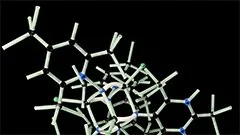Introduction
Gluconeogenesis is a metabolic pathway that allows for the synthesis of glucose from non-carbohydrate precursors such as lactate, pyruvate, glycerol, and certain amino acids. This process is crucial in maintaining blood glucose levels during periods of fasting or prolonged exercise. In this course, we will delve into the details of the gluconeogenesis pathway, its regulation, and its role in overall metabolism.
Overview of Gluconeogenesis Pathway
The gluconeogenesis pathway consists of nine enzymatic reactions that are reversible versions of those involved in glycolysis. The key difference between the two pathways is the direction of flow: glucose is converted to pyruvate during glycolysis, while pyruvate and other substrates are converted to glucose during gluconeogenesis.
Preparation of Substrates for Gluconeogenesis
The substrates for gluconeogenesis can be derived from several sources: lactate, pyruvate, glycerol, and certain amino acids (alanine, aspartate, and serine). These substrates undergo various reactions to prepare them for entry into the gluconeogenic pathway.
Pyruvate Carboxylation
Pyruvate is carboxylated by the enzyme pyruvate carboxylase (PC) to form oxaloacetate (OAA), which is an intermediate in both glycolysis and gluconeogenesis. This reaction requires ATP and biotin as cofactors.
Oxaloacetate Conversion to Phosphoenolpyruvate
Phosphoenolpyruvate (PEP) is formed from OAA through a series of reactions catalyzed by phosphoenolpyruvate carboxykinase (PEPCK). This reaction requires GTP as an energy source.
Gluconeogenic Reactions
The following six enzymatic reactions convert PEP to glucose-6-phosphate (G6P), which can be further converted to glucose by the enzyme phosphoglucomutase. These reactions are the reversed versions of those found in glycolysis.
1. Phosphoenolpyruvate to Pyruvate Conversion
PEP is converted to pyruvate by the enzyme pyruvate kinase (PK). This reaction releases one molecule of ATP and produces pyruvate, which can be carboxylated back to OAA during gluconeogenesis.
2. Pyruvate Conversion to Phosphopyruvic Acid
Phosphopyruvic acid (PPA) is formed from pyruvate by the enzyme pyruvate phosphate dikinase (PPDK). This reaction consumes ATP and produces ADP.
3. Phosphopyruvic Acid Conversion to Oxaloacetate
PPA is converted back to OAA through a series of reactions catalyzed by the enzyme enolpyruvyl shikimate phosphate (EPSP) synthase. This reaction consumes ATP and produces PPi (phosphate inorganic).
4. Oxaloacetate Conversion to Malate
OAA is converted to malate by the enzyme malate dehydrogenase (MDH), using NADP+ as a cofactor. This reaction consumes one molecule of NADPH and produces NADP+.
5. Malate Conversion to Fumarate
Malate is converted to fumarate by the enzyme malic enzyme (ME), using NADP+ as a cofactor. This reaction consumes one molecule of NADPH and produces NADP+.
6. Fumarate Conversion to Succinate
Fumarate is converted to succinate by the enzyme fumarase (FA), which does not require a cofactor. This reaction does not involve a net change in free energy.
Regulation of Gluconeogenesis Pathway
The gluconeogenic pathway is tightly regulated to ensure that glucose synthesis occurs only when necessary, such as during periods of fasting or prolonged exercise. The regulation primarily targets the enzymes involved in the first two steps of the pathway: pyruvate carboxylase and phosphoenolpyruvate carboxykinase.
Pyruvate Carboxylase Regulation
Pyruvate carboxylase activity is regulated by allosteric activation, feedback inhibition, and covalent modification. Allosteric activators of PC include acetyl-CoA and ATP, while substrates such as pyruvate and malate act as allosteric inhibitors. Feedback inhibition occurs through the product OAA, which inhibits PC activity by binding to its active site. Covalent modification of PC involves phosphorylation and dephosphorylation, with AMP-activated protein kinase (AMPK) playing a key role in this process.
Phosphoenolpyruvate Carboxykinase Regulation
Phosphoenolpyruvate carboxykinase activity is regulated by allosteric activation and covalent modification. Allosteric activators of PEPCK include citrate, ATP, and Ca2+, while inhibitors include NADH and AMP. Covalent regulation of PEPCK involves phosphorylation and dephosphorylation, with hormonal signals such as glucagon and epinephrine playing a crucial role in this process.
Role of Gluconeogenesis in Overall Metabolism
Gluconeogenesis plays a vital role in maintaining blood glucose levels during periods of fasting or prolonged exercise, as well as during pregnancy and lactation. The regulation of the gluconeogenic pathway ensures that glucose synthesis occurs only when necessary, thereby conserving energy and preventing unnecessary glucose production.
Summary
In this course, we have explored the details of the gluconeogenesis pathway, its substrates, reactions, regulation, and role in overall metabolism. Understanding the complex interplay between glycolysis, gluconeogenesis, and other metabolic pathways is essential for comprehending the intricate network that governs cellular energy metabolism.
MCQ: Test your knowledge!
Do you think you know everything about this course? Don't fall into the traps, train with MCQs! eBiologie has hundreds of questions to help you master this subject.
These courses might interest you
Create a free account to receive courses, MCQs, and advice to succeed in your studies!
eBiologie offers several eBooks containing MCQ series (5 booklets available free for each subscriber).



